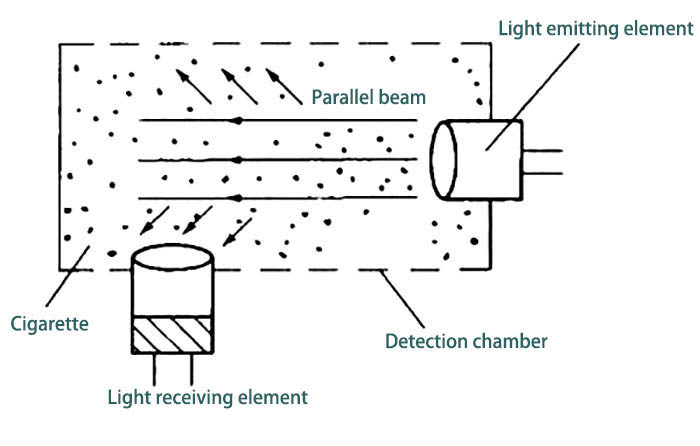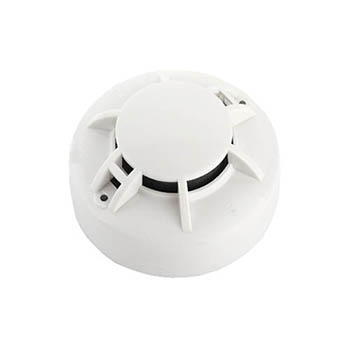What is Photoelectric Smoke Detector?
The photoelectric smoke detector is composed of a light source, a photoelectric element and an electronic switch. It is developed by utilizing the basic property that the smoke generated during a fire can change the propagation characteristics of light. The photoelectric smoke detector adopts a photoelectric sensor with a special structure design, which has the advantages of high sensitivity, stability and reliability, low power consumption, beautiful and durable, and easy to use. Its circuit and power supply can be self-tested, and analog alarm tests can be performed.
How do photoelectric smoke detectors work?
The photoelectric smoke detector detects fire by using the fire smoke to absorb and scatter light. When the infrared beam of the infrared emission tube is scattered by the smoke particles, the intensity of the scattered light is proportional to the concentration of the smoke. And the infrared light received by the photosensitive tube, the strength of the light beam will change, which will be transformed into a point signal, and finally transformed into an alarm signal.
When smoke particles interact with light, there are two different processes: the particles can re-radiate the received energy at the same wavelength, and the re-radiation can occur in all directions, but the radiation intensity in different directions is different, which is called scattering; On the one hand, radiant energy can be converted into other forms of energy, such as thermal energy, chemical energy or secondary radiation of different wavelengths, which is called absorption.
In order to detect the existence of smoke, a beam of light emitted by the transmitter can be hit on the smoke: if it is on its optical path, the method of determining the smoke by measuring the attenuation effect of the smoke on the light is called the dimming detection method; Outside the optical path, the method of determining the smoke by measuring the light energy generated by the scattering of the smoke on the light is called the scattering detection method.
Photoelectric smoke detectors are mainly composed of two parts: a light-emitting element and a light-receiving element. In order to eliminate the interference of ambient light on the light-receiving components, the receiving and transmitting components are installed in a small dark room, where smoke can enter but light cannot enter. This is a point-type photoelectric smoke detector. When the receiving and transmitting components are installed in a large-scale open space, the smoke on the optical path between the transmitting and receiving is detected, which constitutes a beam-to-radiation smoke detector. In the visible and near-infrared spectrum range, for black smoke, the light attenuation is dominated by absorption, while for gray and white smoke, it is mainly scattered.
The photoelectric smoke detector with smart chip can effectively sense different types of fire smoke. Its internal use of special integrated circuits can analyze the fire mode and avoid human errors. Due to the special material and structure of infrared photoelectric smoke, the detector can effectively avoid dust adhesion. The intelligent photoelectric smoke detector adopts an anti-electromagnetic interference infrared receiver, which can effectively eliminate other electronic interference sources in the room. At the same time, it uses the principle of light scattering to detect the smoke generated in the early stage of the fire and sends out an alarm signal in time.
How to classify photoelectric smoke detector?
According to the absorption and scattering of light by smoke particles, photoelectric fire detectors can be divided into two types: dimming type and scattered light type.
Dimming
The smoke particles entering the photoelectric detection chamber absorb and scatter the light emitted by the light source, reducing the luminous flux passing through the optical path, thereby reducing the photocurrent generated on the light receiving element. The change of the photocurrent relative to the initial calibration value reflects the concentration of the smoke. Based on this, the fire information can be amplified and compared by threshold value, analogous judgment processing or fire parameter calculation through the electronic circuit, and finally the corresponding fire signal is generated through the transmission circuit, forming a switch fire detector, an analog fire detector or a distributed  intelligent fire detector.
intelligent fire detector.
The principle of dimming photoelectric fire smoke detector can be used to form a fire detector with a point structure, and a small dark box-type smoke detection chamber is used to detect the smoke concentration generated by a fire to achieve effective fire detection. The principle of dimming photoelectric smoke detection is more suitable for fire detectors with a linear structure to realize large-area fire detection, such as active infrared beam smoke detectors with separate receiving and emitting devices.
Scattered light
The smoke particles entering the shading darkroom have a scattering effect on the light of a certain wavelength emitted by the light emitting element (light source) (according to the law of light scattering, the smoke particles need to be slightly colored, and when the particle size is larger than the wavelength of light, it will produce scattering effect). The impedance of the light-receiving element (photosensitive element) at a certain angle position changes to generate photocurrent. The size of this photocurrent is related to the intensity of scattered light, and is determined by the concentration, particle size and coloring of smoke particles.
According to the photocurrent of the light-receiving element (without smoke particles, the photocurrent is about the dark current), that is to say, when the concentration of smoke particles reaches a certain value, the energy of the scattered light is enough to generate a photocurrent of a certain size for excitation, which can be used for excitation a signal processing circuit outside the darkroom and sends out a fire signal. Obviously, the signal processing circuits outside the darkroom adopt different structures and data processing methods, and can form different types of fire detectors, such as threshold alarm switch fire detectors, analog judgment analog fire detectors, and parameter calculation intelligent fire detectors device.
Applicable places of photoelectric smoke detector
Photoelectric smoke detectors are suitable for situations where visible smoke is produced before fire spreads. It is generally applicable to the interior of buildings, especially suitable for places with high electrical fire hazards, such as cable trenches, inside the cabinets of electronic equipment rooms, etc. When electronic components are overheated, more visible smoke will often be produced.
Places where photoelectric smoke detectors are not suitable include places that may generate black smoke, places with a large amount of dust, places where water mist stays, places where steam may be produced, places where oil mist is produced, places where smoke stays under normal conditions, etc.
What are the precautions for photoelectricsmoke alarms?
Users should pay attention to the installation position of the alarm when using the smoke detectors. Try not to install the smoke detector in a place with a lot of smoke, because the smoke detector can detect tiny smoke particles, which will cause false alarms. Generally speaking, smoke detectors are most commonly installed on the ceiling, at least 30 cm away from walls or lamps.
In addition to the above-mentioned installation locations, users should also consider whether to purchase interconnected smoke detectors, so that smoke or heat detected in the warehouse can trigger an alarm throughout the room to arouse people's attention to the greatest extent.
Smoke detectors usually work around the clock. So after a long time of use, the internal components will age and the induction will not be sensitive. The detector needs to be replaced after 5 years of service life. In addition, during use, regular cleaning is required to remove accumulated dust. Especially the light source and the surface of the lens must not have dust, otherwise it will cause a significant drop in sensitivity or even malfunction.
Smoke detectors mostly use batteries to work. If the detector emits an indirect single sound, it means that the battery in the product is about to run out. Users should pay special attention to it and replace the battery in time.

